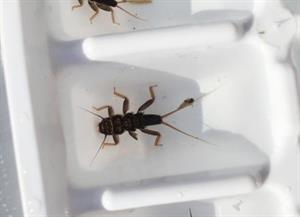Heather Black, Chesapeake Conservation Corps volunteer
There are many ways to measure water quality in local streams. Here at the Izaak Walton League, we’ve found that sampling aquatic macroinvertebrates (aka “stream bugs”) is an inexpensive and accurate test of stream health – one that any citizen scientist can tackle. (Read our “Bugging Out on Stream Monitoring" blog for details on why macroinvertebrates matter for stream monitoring.)
The League’s Save Our Streams (SOS) volunteer stream monitoring program asks volunteers to identify 24 different macroinvertebrates in order to measure stream health. This is a small number of stream bugs compared with the thousands there are in the world. But even 24 can be hard to identify if it is your first time out in the field. That’s why the League developed resources to help you. You can find links to our macroinvertebrate guidebook and waterproof identification brochure on our SOS Equipment web page. But the number one resource we like to use, especially with new stream monitors, is the Aqua Bugs app. This app uses a dichotomous key – a tool that provides a series of choices that will lead to correct identification of each macroinvertebrate.
It’s simple to use – and it’s free. Once you open the Aqua Bugs app, you can start the identification process based on a macroinvertebrate’s legs, tails, or overall body shape, using illustrations to guide you through the choices.
Let’s go through the process using the macroinvertebrate in this ice cube tray.
Start with the body. From this image it is clear that the macroinvertebrate does not have a shell, so we can eliminate clams and mussels.
Next, does it have legs? Yes! How many? Six. (Watch for fleshy appendages or gills, which can be mistaken for legs.) Now we move on to tails, specifically whether or not our macroinvertebrate has any.
Another yes. It has two. Look carefully when examining for tails – they can easily break off. Finally, does the organism have gills along its abdomen? No.
If you followed along with the Aqua Bugs app, you discovered that the macroinvertebrate pictured here is a stonefly larva. The key features when identifying stonefly larva are the number of tails, number of legs, overall length of antennae, and smooth abdomen (no gills).
The app will then ask if this is your bug. In our case, it is. However, if you did not get stonefly, click “Not my bug.” The app will then provide a list of other potential candidates. It also offers multiple photos of each macroinvertebrate as well as a list of all the macroinvertebrates we use in stream monitoring.
It may take a little practice to identify the macroinvertebrates you will be looking for. Now you know there’s an app for that – one you can get from the Izaak Walton League.